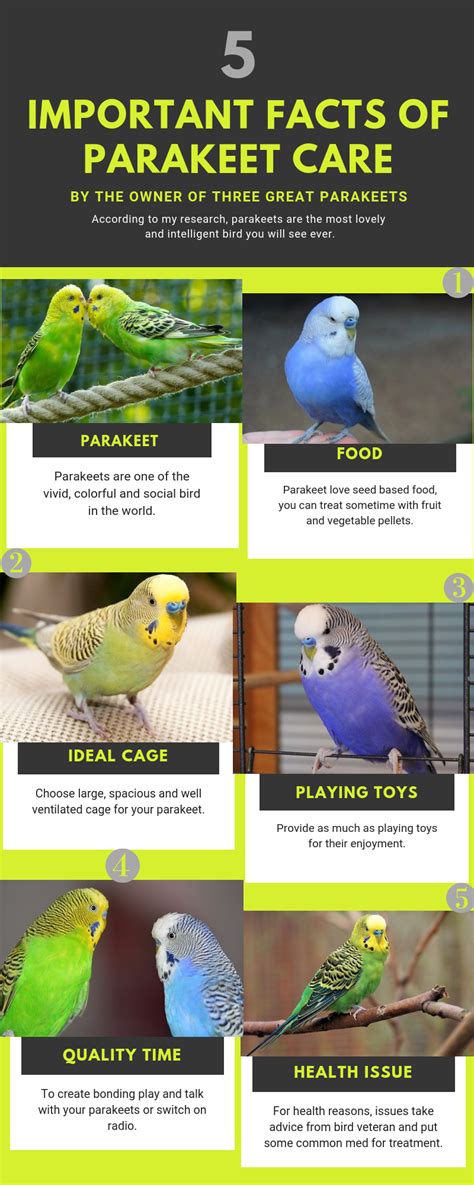Introduction
As one of the most popular pet birds, parakeets, also affectionately known as budgies, bring joy and companionship to countless households. Their vibrant plumage, playful antics, and charming personalities make them an endearing part of many families.

To ensure the well-being and happiness of these feathered friends, it’s crucial to provide them with proper care and attention. This comprehensive guide will delve into the essential aspects of parakeet care, covering everything from nutrition and housing to behavior and socialization.
Essential Parakeet Care
1. Nutrition
- Seed-based diet: Form the foundation of a parakeet’s diet. Choose high-quality seed mixes that are specifically designed for parakeets.
- Pellets: A balanced alternative to seeds, offering a complete range of nutrients. Gradually introduce pellets into the diet by mixing them with seeds.
- Fruits and vegetables: Provide fresh produce such as leafy greens, carrots, apples, and berries as a source of vitamins and minerals.
2. Housing
- Cage: Choose a cage that is spacious enough for your parakeet to move around comfortably, with ample room for toys, perches, and food and water bowls.
- Perches: Provide multiple perches of different sizes and textures to encourage natural climbing and foot exercise.
- Toys: Offer a variety of toys to stimulate your parakeet’s mind and provide entertainment, such as bells, mirrors, and swings.
3. Health and Hygiene
- Veterinary care: Regular veterinary check-ups are essential for preventive care and early diagnosis of any health issues.
- Grooming: Provide your parakeet with a shallow dish of water for bathing. You can also mist them with lukewarm water to promote feather health.
- Nail trimming: If necessary, trim your parakeet’s nails to prevent overgrowth.
Parakeet Behavior
1. Socialization
- Flocking instinct: Parakeets are naturally social birds and thrive in pairs or small flocks. Consider getting multiple birds to provide companionship.
- Bonding: Parakeets can form strong bonds with their human companions. Spend time interacting with your bird through talking, playing, and handling.
2. Communication
- Vocalizations: Parakeets are known for their cheerful chirps and whistles. They may also mimic human sounds or other sounds in their environment.
- Body language: Observe your parakeet’s body postures and movements to understand its mood and intentions.
3. Playful and Curious
- Exploration: Parakeets love to explore their surroundings. Provide a variety of toys and objects to encourage curiosity and engagement.
- Learning and training: Parakeets can learn tricks and behaviors through positive reinforcement. Use treats or praise to reward desired actions.
Common Parakeet Problems
1. Feather plucking
- Stress: Can be caused by a lack of socialization, boredom, or other environmental factors.
- Solution: Address underlying stress triggers and provide a stimulating and engaging environment.
2. Aggression
- Hormonal changes: Especially during breeding season, parakeets may exhibit territorial aggression.
- Solution: Separate aggressive birds and provide plenty of space and distractions.
3. Respiratory problems
- Bacterial infections: Common in overcrowded or unsanitary conditions.
- Solution: Maintain a clean environment, provide fresh air, and seek veterinary attention if symptoms persist.
4. Parasitic infestations
- Mites: Can cause skin irritation and feather loss.
- Solution: Treat with antiparasitic medications and thoroughly clean the cage and surroundings.
Conclusion
Providing proper care for your parakeet is essential for its health, happiness, and longevity. By following the guidelines outlined in this guide, you can create a nurturing environment where your feathered friend can thrive and bring years of joy to your family.
Remember, your parakeet is a living companion that deserves love, attention, and the best possible care. By being a responsible and dedicated owner, you can ensure that your little budgie has a long and fulfilling life at your side.
Additional Tips
- Regular cage cleaning: Remove droppings and uneaten food daily. Thoroughly clean the cage with disinfectant once a week.
- Quarantine new birds: Before introducing new birds to your flock, quarantine them for 30 days to prevent the spread of diseases.
- Provide a cuttlebone: A source of calcium and minerals essential for bone and beak health.
- Consider clicker training: A positive reinforcement technique that can be used to teach tricks and encourage desirable behaviors.
- Respect your parakeet’s boundaries: Avoid handling or petting your bird when it does not want to be disturbed.
Tables
Table 1: Recommended Cage Size for Parakeets
| Number of Birds | Cage Dimensions (Length x Width x Height in Inches) |
|---|---|
| 1 | 18 x 12 x 18 |
| 2 | 24 x 18 x 18 |
| 3-4 | 30 x 18 x 18 |
Table 2: Parakeet Dietary Guidelines
| Food Group | Proportion in Diet |
|---|---|
| Seeds | 50-60% |
| Pellets | 20-30% |
| Fruits and vegetables | 10-20% |
Table 3: Common Parakeet Behaviors and Their Meanings
| Behavior | Meaning |
|---|---|
| Fluffed feathers, closed eyes | Sleepy or comfortable |
| Raised tail, lowered head | Aggressive or defensive |
| Chirping and whistling | Happy or excited |
| Beak grinding | Content or relaxed |
| Bobbing head | Eager to mate or sing |
Table 4: Parakeet Health Problems and Their Symptoms
| Health Problem | Symptoms |
|---|---|
| Feather plucking | Loss of feathers, especially around the chest or back |
| Respiratory problems | Wheezing, coughing, sneezing |
| Parasitic infestations | Scaly skin, feather loss, itching |
| Bacterial infections | Diarrhea, lethargy, sneezing, discharge from eyes or beak |





















